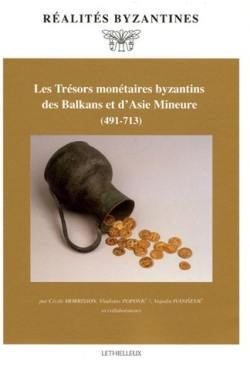
Fiche technique
Format : Broché
Nb de pages : 454 pages
Poids : 865 g
Dimensions : 18cm X 25cm
EAN : 9782283604656
Les trésors monétaires byzantins des Balkans et d'Asie Mineure (491-713)
Quatrième de couverture
Réalités Byzantines
Ce livre couvre une période décisive (491-713) au cours de laquelle la chute du limes danubien, puis l'installation des Slaves conduisirent à la disparition des transactions en espèces sur la majorité du territoire balkanique. En Asie Mineure, la guerre et l'invasion perses (610-630) puis la poussée arabe à partir de 636 entraînèrent ou accentuèrent le déclin de l'urbanisation et de la monétarisation. Issu d'une longue collaboration entre spécialistes des différents pays concernés, il offre l'inventaire détaillé de presque tous les trésors monétaires des Balkans et d'Asie Mineure connus pour cette période (374 au total). Cette base documentaire attendue par les archéologues et les numismates, est précédée d'une introduction et de plusieurs commentaires régionaux ou thématiques destinés aux historiens, accompagnés de nombreux tableaux, graphiques et cartes. Signe fréquent d'insécurité, les trésors localisent et datent en partie les invasions et leurs routes ; leur répartition géographique illustre la rétraction progressive de la circulation monétaire. Enfin le matériel cumulé des trésors (8 915 pièces identifiées, dont 2 212 en or, 188 en argent et 6 515 en cuivre) permet d'étudier les grands traits de l'évolution des frappes et de leur circulation.
This book considers a dramatic period (late 5th-early 8th centuries) in which the fall of the limes on the Danube and the settlement of Slavs led to the disappearance of cash exchanges in most of the Balkans. At the same time in Asia Minor, the Persian war and invasion (610-30) followed by the Arab thrust from 636 onward aggravated the decline of cities and of monetisation. Drawing on a long collaboration between scholars from the relevant countries, the book proposes a detailed inventory of most of known coin boards (374) from the Balkans and Asia Minor, buried between 491 and 713. This documentation, classified according to Byzantine provinces, will be welcome by archaeologists and numismatists. It is introduced by regional and thematic commentaries intended for historians and is accompanied by numerous tables, charts and maps. Often related with insecurity, boards partly date invasions and plot their inroads, while their geographical distribution gives evidence of the progressive retraction of monetary circulation. Finally, the consolidated material of these deposits (8 915 identified coins - 2 212 gold, 188 silver and 6 515 bronze) allows to outline the structure of issues, their evolution and their regional distribution.





